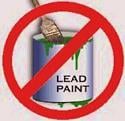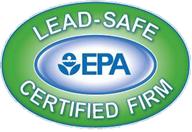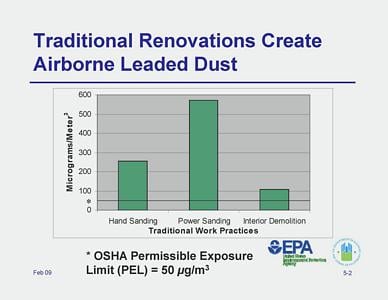Making RRP Easier - New Understandings About RRP Work Practices

Guest Blogger: Dean Lovvorn is a residential remodeler who has done numerous RRP projects. He is also a Lead Inspector, Lead Risk Assessor and EPA RRP Renovator Instructor.
This blog post is a follow-up to a previous RRPedia Guest Blog where Dean listed several differences between the work practices taught in the required Certified Renovator class and what he found is actually required in the RRP rule.
Making RRP Easier - New Understandings About RRP Work Practices
Back in April 2010, I had an exterior remodeling job that was put on hold for a day because of heavy rains. In my boredom, I decided to read the actual RRP law from start to finish. I soon discovered that what I was taught in my 8 hour class and what was in the student manual wasn’t necessarily in the actual law itself.
I was probably dozing off in the 8 hour renovator class, but after these discoveries, I began to clarify some new understandings.
- On exterior containment set-ups, all I really needed to do was put plastic on the ground, be sure windows & doors were closed, cover any doors within 20 feet with plastic and put out a warning sign. If there are no doors and/or windows within 20 feet, simply put plastic on the ground and a warning sign up. Nothing else needed.
- On interior containment set-ups, I just needed to do the same as the exterior (except 6 feet out from where I was working). If there were no furniture/objects or ducts within the 6 foot area … I didn’t have to go any further. Be sure to tape down the plastic on the floor.
Of course, if I was doing some really dusty work, I made the containment (work area) larger, but other than that, it was pretty quick, easy and simple if you were to ask me.
Following are some examples of how reading the actual law has helped me.
Siding Replacement
 In this example, I would place 3.5 mil plastic (from Home Depot), instead of the 6 mil plastic 10 feet out on the ground. Then, I would make sure doors/windows were closed, put plastic over any doors and then put up the warning sign. I would also run a plastic runner out to the dumpster and surround the ground around the dumpster with plastic. Doing the containment this way, saves me from having to wrap, bag or HEPA vac the siding (or myself). This is because I can dump the siding without ever going outside the containment area.
In this example, I would place 3.5 mil plastic (from Home Depot), instead of the 6 mil plastic 10 feet out on the ground. Then, I would make sure doors/windows were closed, put plastic over any doors and then put up the warning sign. I would also run a plastic runner out to the dumpster and surround the ground around the dumpster with plastic. Doing the containment this way, saves me from having to wrap, bag or HEPA vac the siding (or myself). This is because I can dump the siding without ever going outside the containment area.
If exterior vertical containment is needed a simple solution (pictured to right) can be done.
Replacing Door Slabs
If my job is to replace 15 door slabs, I simply do this without following RRP. This is because the only area I am disturbing on each door is the hinge area and since it falls under the Minor Repair and Maintenance Activities, RRP is not required. This insight came from the FAQ section of the EPA web site.
Bathroom Remodel (Total Gut)
 I can demo the tile, tub, shower, toilet and remove the demolition debris without doing any RRP. After that has been done, I cover up ducts with plastic, make sure windows are closed, close doors and cover with plastic, put up a warning sign and then cover the subfloor with plastic (6 feet out from where I will be working).
I can demo the tile, tub, shower, toilet and remove the demolition debris without doing any RRP. After that has been done, I cover up ducts with plastic, make sure windows are closed, close doors and cover with plastic, put up a warning sign and then cover the subfloor with plastic (6 feet out from where I will be working).
I put the demoed walls, cabinets and trim into trash cans (with lids on top) and HEPA vac the outside of the trash cans (along with myself) before taking them out of the containment area.
Note: If I’m lucky and there is an exit door (to the outside) close by … I could run plastic to the door, then outside to the dumpster. This way, I wouldn’t need to worry about containing the demolition debris.
Normally, I do the final clean-up, visual inspection and cleaning verification after demolition; so that I can officially end RRP and let non-certified electricians/plumbers/sub-contractors into the work area.
Conclusion
 It very well could be that if you did a little homework by reading the actual law, you could reduce the cost of compliance on many jobs to less than 5%. Few contractors will lose a job because they are higher by less than 5%. Plus, with the cost less than 5%, I don’t even mention RRP to my clients during the estimation process anymore, which has helped to improve sales.
It very well could be that if you did a little homework by reading the actual law, you could reduce the cost of compliance on many jobs to less than 5%. Few contractors will lose a job because they are higher by less than 5%. Plus, with the cost less than 5%, I don’t even mention RRP to my clients during the estimation process anymore, which has helped to improve sales.

 Looking for accurate information about the EPA RRP rule?
Looking for accurate information about the EPA RRP rule? 


 There was no mention of having to wear disposable suits, dust mask, booties or headwear. (Still might need to comply with OSHA)
There was no mention of having to wear disposable suits, dust mask, booties or headwear. (Still might need to comply with OSHA) It didn’t say I had to use 6 mil plastic, which made me happy since the 3.5 mil plastic sold at Home Depot cost less.
It didn’t say I had to use 6 mil plastic, which made me happy since the 3.5 mil plastic sold at Home Depot cost less. I suggest the real problem is that the original rule was poorly conceived and poorly written. Because we are now stuck with it, the proposed amendments are really just band-aid approaches to try to make it better for or more palatable to those affected by the rule. What we really need is a new well thought out rule to replace the existing rule, with the input and leadership of the industry this time. And, the industry needs to be proactive this time in its writing, its content and its enforcement.
I suggest the real problem is that the original rule was poorly conceived and poorly written. Because we are now stuck with it, the proposed amendments are really just band-aid approaches to try to make it better for or more palatable to those affected by the rule. What we really need is a new well thought out rule to replace the existing rule, with the input and leadership of the industry this time. And, the industry needs to be proactive this time in its writing, its content and its enforcement. Not using lead safe practices on a pre 1978 property is a big risk. Unless the house is pretested before renovations there is no point of reference regarding existing contamination. If lead safe work practices are not used, how will the business prove it did not cause the contamination?
Not using lead safe practices on a pre 1978 property is a big risk. Unless the house is pretested before renovations there is no point of reference regarding existing contamination. If lead safe work practices are not used, how will the business prove it did not cause the contamination?
 The following is a partial list of links you can use to find information, resources and instructions for working lead safe. This information can be used by renovators, landlords, tenants and homeowners. I suggest checking them out. I found many good work practices, ideas and options to consider that were not offered or discussed in the required Certified Renovator Training class. Renovators may also find some of the documents valuable to share with prospects and clients when discussing pre-1978 renovations and or if the prospect is considering doing all or part of the work themselves.
The following is a partial list of links you can use to find information, resources and instructions for working lead safe. This information can be used by renovators, landlords, tenants and homeowners. I suggest checking them out. I found many good work practices, ideas and options to consider that were not offered or discussed in the required Certified Renovator Training class. Renovators may also find some of the documents valuable to share with prospects and clients when discussing pre-1978 renovations and or if the prospect is considering doing all or part of the work themselves. Links to Information,Resources and Instructions About Working Lead-Safe
Links to Information,Resources and Instructions About Working Lead-Safe Anne points out that EPA Administrator Lisa was quoted to say “EPA is back on the job" and that EPA has received the largest enforcement budget in its history, making it more likely that your business will be subject to some type of investigation.
Anne points out that EPA Administrator Lisa was quoted to say “EPA is back on the job" and that EPA has received the largest enforcement budget in its history, making it more likely that your business will be subject to some type of investigation.  Although a written request for information should specify the statutory authority for the request, don't assume that the agency actually has the cited authority. Knowing the source of the government's authority for the request, as well as determining the applicability of the request to your business, is imperative in both limiting the scope of your response and protecting your business interests with customers and other parties that may be affected by the request.
Although a written request for information should specify the statutory authority for the request, don't assume that the agency actually has the cited authority. Knowing the source of the government's authority for the request, as well as determining the applicability of the request to your business, is imperative in both limiting the scope of your response and protecting your business interests with customers and other parties that may be affected by the request.

 So it appears that a non-certified firm can do the work if testing that proved no lead was found was done by someone else, as long as the determination was made by a certified lead inspector or risk assessor, or by a certified renovator using an EPA recognized test kit and following the kit manufacturer’s instructions. The key is however, that the non-certified firm must have written proof from the person or business that did the testing that there is no lead in the work areas to be disturbed.
So it appears that a non-certified firm can do the work if testing that proved no lead was found was done by someone else, as long as the determination was made by a certified lead inspector or risk assessor, or by a certified renovator using an EPA recognized test kit and following the kit manufacturer’s instructions. The key is however, that the non-certified firm must have written proof from the person or business that did the testing that there is no lead in the work areas to be disturbed.
 There has been a lot of confusion regarding the details of the EPA RRP rule. One that seems to pop up over and over is certification requirements for sub contractors. There are two different certification considerations regarding sub contractors; firm certification and worker certification. Let’s take a look at each separately.
There has been a lot of confusion regarding the details of the EPA RRP rule. One that seems to pop up over and over is certification requirements for sub contractors. There are two different certification considerations regarding sub contractors; firm certification and worker certification. Let’s take a look at each separately. Whether working for the general contractor as a trade partner or a 1099 sales person (offers the work), sub contractors must become certified firms by apply for certification through the EPA. Ensuring that the subs they use are certified firms is particularly important for general contractors, because as part of the required documentation under the rule, the renovation checklist must include the names of all workers who participated in RRP activities on the job. If a sub contractor and his workers do work on the job and the sub’s firm is not certified, the EPA will easily be able to find both the general contractor and the sub in violation of the rule. If a general contractor knows that subs must be certified firms, hiring a non-certified firm to work on a job becomes a knowing and willful violation of the rule, which brings with it serious penalties. It’s also one easy way for a customer’s lawyer to suggest the contractor is/was negligent.
Whether working for the general contractor as a trade partner or a 1099 sales person (offers the work), sub contractors must become certified firms by apply for certification through the EPA. Ensuring that the subs they use are certified firms is particularly important for general contractors, because as part of the required documentation under the rule, the renovation checklist must include the names of all workers who participated in RRP activities on the job. If a sub contractor and his workers do work on the job and the sub’s firm is not certified, the EPA will easily be able to find both the general contractor and the sub in violation of the rule. If a general contractor knows that subs must be certified firms, hiring a non-certified firm to work on a job becomes a knowing and willful violation of the rule, which brings with it serious penalties. It’s also one easy way for a customer’s lawyer to suggest the contractor is/was negligent.

 Another key consideration in paint removal is the impact on wood, especially old, more valuable wood. Chemicals leach out natural resins and leave residue even after rinsing. High heat (1,100ºF) guns force paint pigment back into the wood and risk scorching and igniting wood. Sanding and shaving leave gouge and burn marks if not done skillfully. Pressure washing and new steam paint removal methods often leave irregular surface marks in the wood, drive moisture back into the wood, and create layers of “gray wood” which must be scraped away and or they will threaten the adherence of new paint. All of these methods can damage wood.
Another key consideration in paint removal is the impact on wood, especially old, more valuable wood. Chemicals leach out natural resins and leave residue even after rinsing. High heat (1,100ºF) guns force paint pigment back into the wood and risk scorching and igniting wood. Sanding and shaving leave gouge and burn marks if not done skillfully. Pressure washing and new steam paint removal methods often leave irregular surface marks in the wood, drive moisture back into the wood, and create layers of “gray wood” which must be scraped away and or they will threaten the adherence of new paint. All of these methods can damage wood. The time for the entire surface preparation process is reduced using the infrared heat method. Set up, operation, and cleanup are faster than with other methods. There is no extra time for rinsing, neutralization, drying, or sanding the wood; it is immediately ready for primer.
The time for the entire surface preparation process is reduced using the infrared heat method. Set up, operation, and cleanup are faster than with other methods. There is no extra time for rinsing, neutralization, drying, or sanding the wood; it is immediately ready for primer.

 The definition of ‘readily available’ varies widely. For example, OSHA allows up to 24 hours for businesses to produce some types of required records. When the EPA inspector walks in and asks for your RRP documents, you should be able to open a file drawer, pull out a box, or hand them a CD with all of your records within a 15 to 30 minute time frame. Otherwise, they pull out their ticket book and start writing violations.
The definition of ‘readily available’ varies widely. For example, OSHA allows up to 24 hours for businesses to produce some types of required records. When the EPA inspector walks in and asks for your RRP documents, you should be able to open a file drawer, pull out a box, or hand them a CD with all of your records within a 15 to 30 minute time frame. Otherwise, they pull out their ticket book and start writing violations. EPA does not allow hearsay compliance. If it isn’t written down, it didn’t happen. You can stand there and tell them that you used containment on every job. But, a picture of your jobsites with you pointing to the warning sign outside your containment demonstrates compliance beyond any doubt. Pictures are worth a thousand words…and don’t forget to set your date and time stamp on your photo.
EPA does not allow hearsay compliance. If it isn’t written down, it didn’t happen. You can stand there and tell them that you used containment on every job. But, a picture of your jobsites with you pointing to the warning sign outside your containment demonstrates compliance beyond any doubt. Pictures are worth a thousand words…and don’t forget to set your date and time stamp on your photo.



